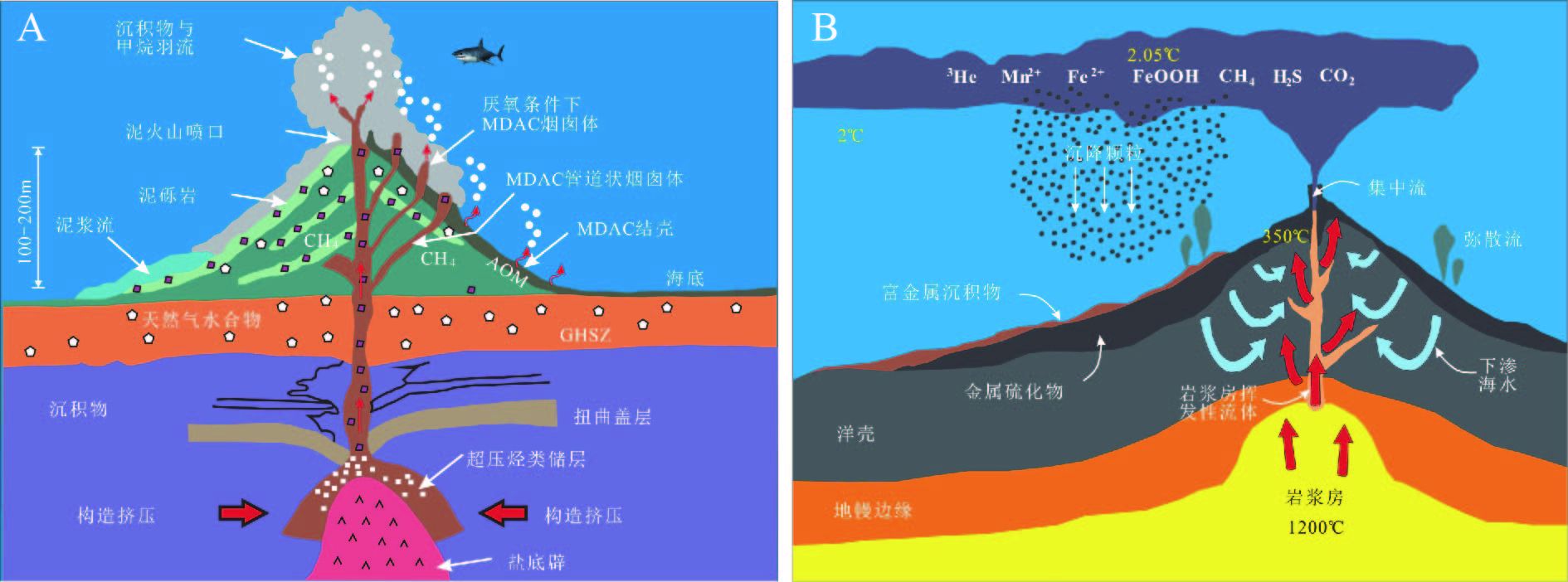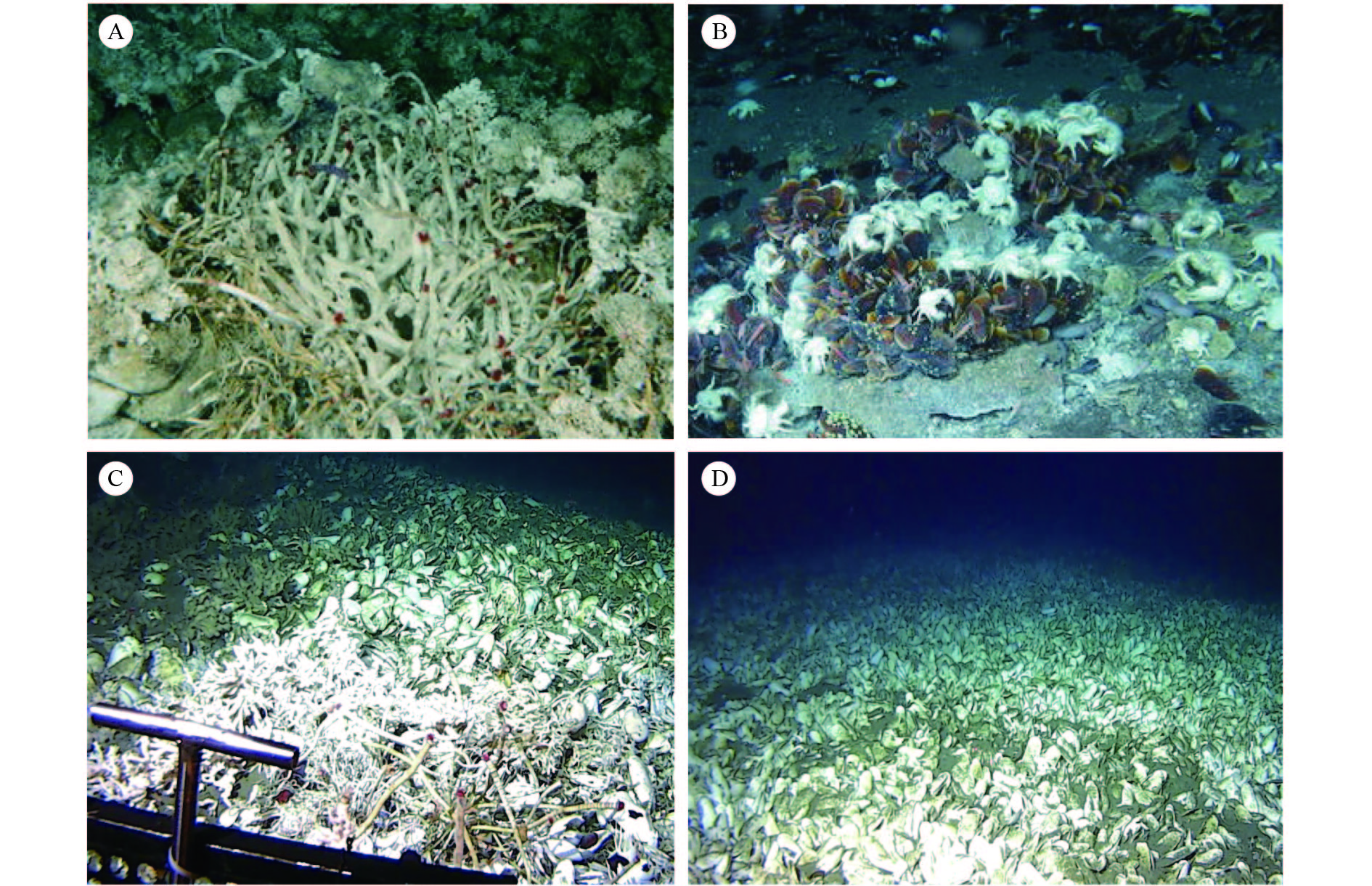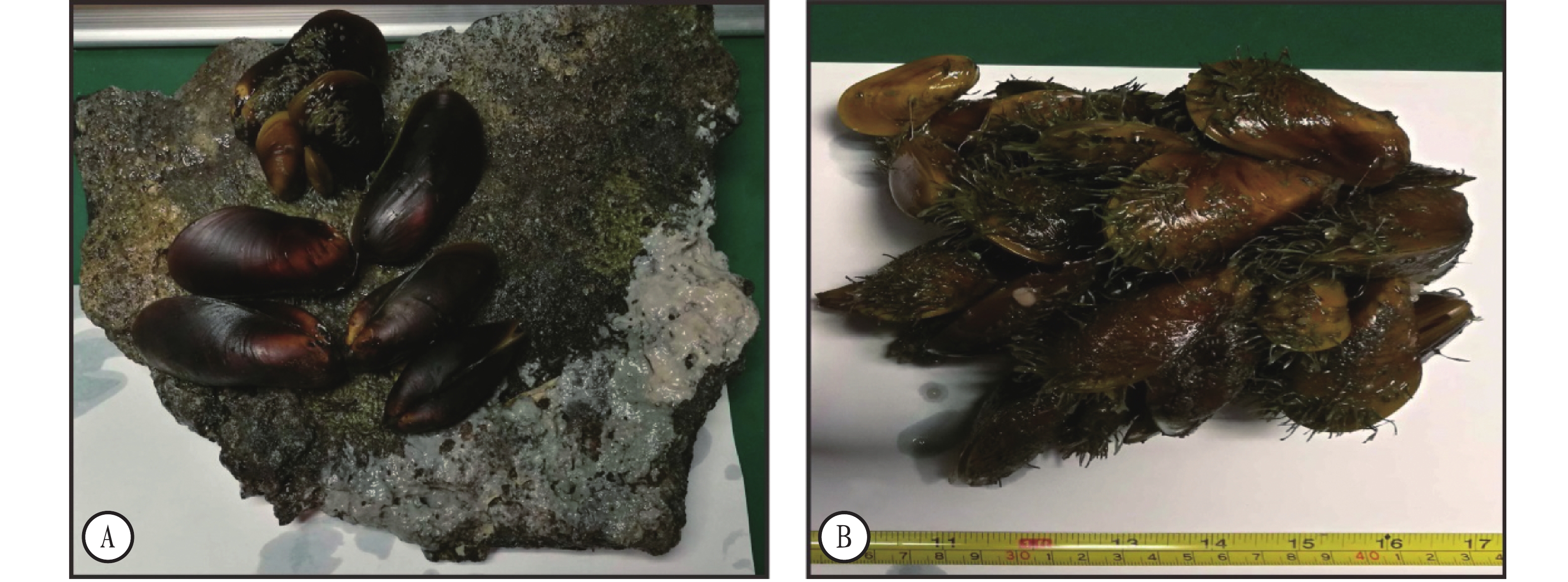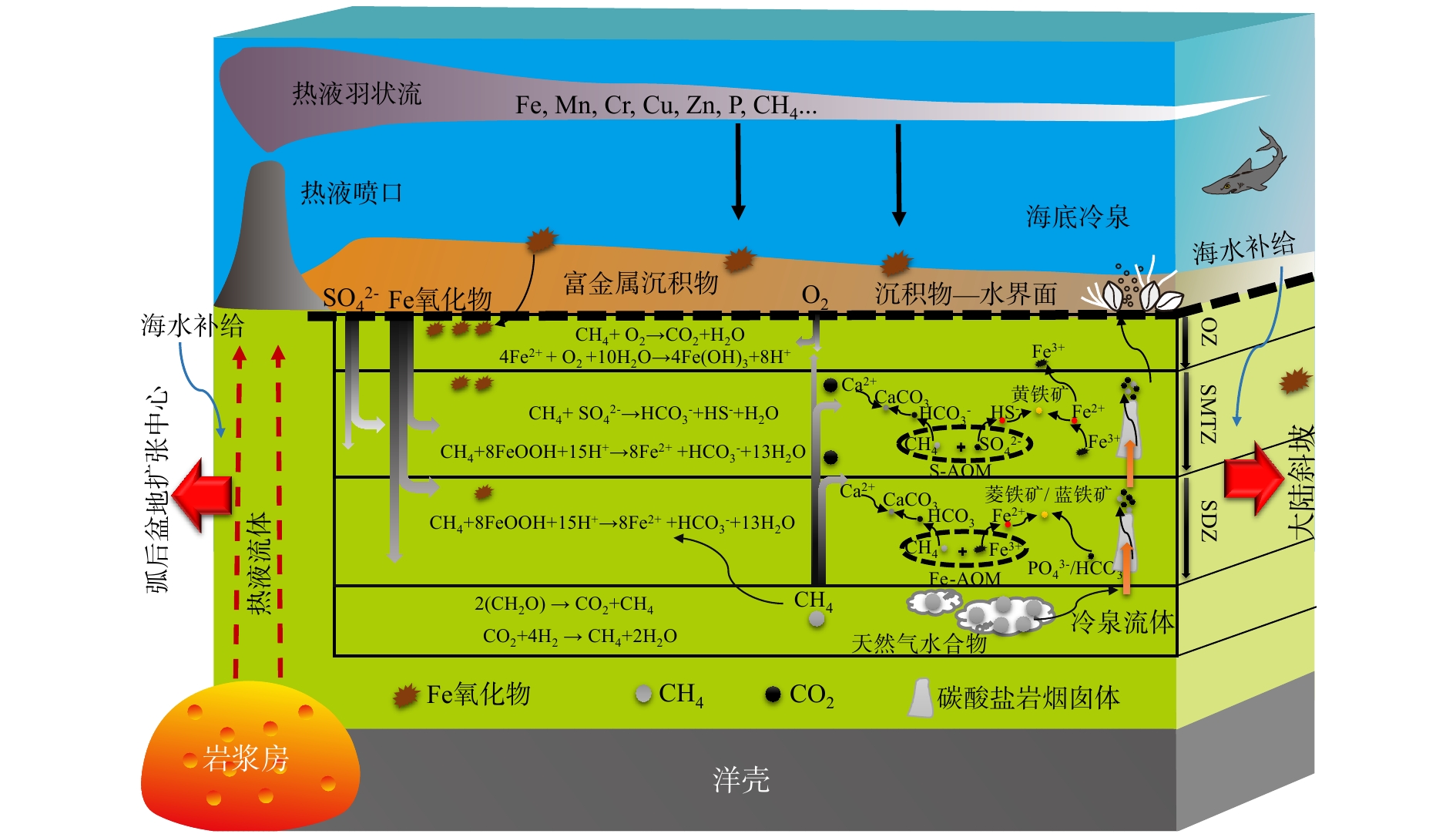Interaction between seafloor cold seeps and adjacent hydrothermal activities in the Okinawa Trough
-
摘要: 热液和冷泉活动是现代深海环境中两个重要的极端系统,它们均是岩石圈与外部圈层之间进行物质、能量转移和交换的重要途径,它们之间既有显著差异,但也存在很多相似点。一系列调查研究表明,在某些特殊构造单元,热液和冷泉活动可能并不是彼此孤立的,而是在构造地质、生物生态和元素循环上存在某种相互作用或耦合关系。冲绳海槽作为西太平洋一个典型的弧后盆地,发育了繁盛的热液和冷泉活动,是研究这两个海底极端系统相互影响机制的天然实验室。在大量文献调研和野外精细探测结果的基础上,分析了冲绳海槽内相互毗邻的冷泉和热液之间的物质扩散过程及生物地球化学作用,初步建立了两个极端系统内两种不同流体相互作用的概念模型,认识到未来如对两个深海极端环境共生区构造发育特征、地层流体演化、生物群落以及矿物元素组成进行系统分析,将有助于建立更加完善的冷泉-热液两个系统在物质和能量上的耦合关系模型,同时也有助于揭示它们在生物生态之间的沟通融合规律,最终可建立盆地尺度上热液-冷泉区相互作用模式,从而加深对西太平洋甚至全球范围内冷泉-热液两个极端环境系统甚至“流体-固体”耦合的规律性认识。Abstract: As the seafloor extreme environmental systems, both hydrothermal vents and cold seeps are the critical pathways between the lithosphere and exosphere (biosphere, hydrosphere and atmosphere) for transfer and exchange of materials and energies. There are significant differences, but also many similarities between the two systems. Recent investigations show that in some special tectonic units, hydrothermal vents and cold seeps are not isolated from each other, but instead there are some interactions or coupling relationships in terms of tectonic geology, biological ecology and element cyclicity. As a typical back-arc basin in the western Pacific Ocean, there are abundant hydrothermal vents and cold seeps developed in the Okinawa Trough (OT). Therefore, it has become an ideal natural laboratory for studying the two extreme environmental systems and their interactions. On the basis of literature researches and careful field case studies, we investigate the material diffusion process and biogeochemical process between cold seeps and hydrothermal vents adjacent to each other within the trough. A conceptual model is then established for the interactions between the fluids from the two extreme systems. Our results suggest that it would help to establish a more complete model of the coupling relationship between the two systems in the future, if the structural development characteristics, pore fluid evolution, biological communities, and mineral chemistry of the two deep-sea extreme environments are systematically analyzed. Moreover, it will help to reveal the interaction between them in biological ecology and finally establish a model of interaction between hydrothermal vents and cold seeps on the basin scale, so as to better understand the interaction process between cold seeps and hydrothermal systems and even the coupling of " flow-solid” in the Western Pacific Ocean or the whole Earth.
-
Keywords:
- hydrothermal activities /
- cold seeps /
- interaction /
- material and energy cycle /
- Okinawa Trough
-
1977年,美国科学家首次在加拉帕戈斯扩张洋脊探测到海底热液活动[1],1983年,又在墨西哥湾佛罗里达陡崖3 200 m的海底发现了海底冷泉活动[2],这两次激动人心的标志性事件正式揭开了人类探索海底极端环境的序幕。有学者将现代海底热液喷口视为20世纪自然科学界最令人瞩目的发现之一[3],而实际上稍后发现的冷泉系统又将该意义予以拓展和加强。因为热液和冷泉均是现代海底极端环境系统的重要组成部分,也是物质从岩石圈向外部圈层(生物圈、水圈和大气圈)进行转移和交换的重要途径甚至中枢环节[4],是地球物质循环的基本过程之一[5],它们的发现将地球圈层之间的物质循环研究开始朝精确化方向发展。同时,海底极端系统的研究促进了地质学、地球化学和生物学等多学科交叉的研究,催生了与海底极端系统相关的研究新方向,迄今已成为当代国际地球科学研究和探索的重大前沿领域之一[3, 5]。
数十年的调查研究表明,海底冷泉和热液两个极端系统对全球海洋物质循环[4]、生命活动[6-7]和成岩成矿过程[8-9]均有重要意义,可谓当前深海探测领域和与之相关的科学研究中相互辉映的“双璧”。但是,长期以来,对于这两个系统的探测与研究却是彼此独立甚至割裂的。虽然它们均作为岩石圈(洋壳)和外部圈层物质交换的途径而存在[10-11],但迄今却从未将其作为一个问题的两部分看待。包括大洋钻探计划(ODP和IODP)在内,无数的航次调查也均是以其中单一系统作为目标,而忽视了另外一个系统。
最近,一系列调查研究表明,海底冷泉和热液活动并不是彼此孤立的,而是在构造地质、生物生态和元素循环上有某种相互作用或耦合关系。我们收集了世界海洋中已经发现的海底热液喷口,将其与可能的冷泉发育区域进行重叠,可以明确发现在某些特殊构造单元冷泉和热液活动在空间上共存,这种情况在西太平洋海域最为显著。全球范围内,粗略地显示8个区域有可能存在冷泉和热液的相互作用,其中有3个位于西太平洋地区,这里面就包括笔者团队已经开展了一系列调查研究工作的冲绳海槽(图1)。
![]() 图 1 世界海洋中已发现热液喷口(蓝色圆点)和可能冷泉发育区(粉色区域,以水合物稳定带代表)的叠置图① 东海冲绳海槽,② 马里亚纳海沟和日本海沟,③ 西南太平洋(以劳盆地和马努斯海盆为典型),④ 东北印度洋脊,⑤ 东地中海,⑥ 北极加克超慢速扩张洋脊,⑦ 北大西洋南缘,⑧ 东北太平洋边缘(底图据Sun et al[12]修改)Figure 1. Geological settings where hydrothermal fields and cold seep systems coexist in the global oceans① Okinawa Trough, East China Sea, ②Mariana and Japan Trench, ③ Extending basins along the Southwest Pacific Ocean (e.g., Manus basin and Lau Basin), ④ Northeast Indian Ridge (Carlsberg Ridge), ⑤ Eastern Mediterranean, ⑥ Arctic Gakkel ultraslow spreading ocean ridge, ⑦ South margin of North Atlantic, ⑧ Northeast Pacific margin. Base map is modified after Sun et al[12]
图 1 世界海洋中已发现热液喷口(蓝色圆点)和可能冷泉发育区(粉色区域,以水合物稳定带代表)的叠置图① 东海冲绳海槽,② 马里亚纳海沟和日本海沟,③ 西南太平洋(以劳盆地和马努斯海盆为典型),④ 东北印度洋脊,⑤ 东地中海,⑥ 北极加克超慢速扩张洋脊,⑦ 北大西洋南缘,⑧ 东北太平洋边缘(底图据Sun et al[12]修改)Figure 1. Geological settings where hydrothermal fields and cold seep systems coexist in the global oceans① Okinawa Trough, East China Sea, ②Mariana and Japan Trench, ③ Extending basins along the Southwest Pacific Ocean (e.g., Manus basin and Lau Basin), ④ Northeast Indian Ridge (Carlsberg Ridge), ⑤ Eastern Mediterranean, ⑥ Arctic Gakkel ultraslow spreading ocean ridge, ⑦ South margin of North Atlantic, ⑧ Northeast Pacific margin. Base map is modified after Sun et al[12]在国家自然科学基金委重大研究计划“西太平洋地球系统多圈层相互作用”重点项目(编号91858208)的支持下,未来我们将以冲绳海槽为典型对象,探索热液和冷泉在构造地质上的共生关系,初步建立冷泉-热液两个系统在物质和能量上的耦合关系模型,以加深对西太平洋极端环境区域流-固相互作用的规律性认识。在已有资料基础上,结合最近调查研究成果,本文将综述热液和冷泉活动之间的异同点,分析冲绳海槽存在热液和冷泉活动相互作用的证据,阐述其关键科学问题,并基于流体特征初步建立两者之间相互作用模式,为后续开展更复杂的相互影响规律的探索奠定基础。
1. 热液与冷泉:深海海底一对同中有异的“孪生兄弟”
1.1 海底热液和冷泉系统之间的相似性
(1)均伴随着重要经济矿藏的形成,具有重要的资源聚集效应。从典型的热液喷口和泥火山型冷泉的结构来看,这两个极端环境分别对应着金属硫化物矿床和天然气水合物矿藏(图2),是当前深海矿床资源勘探最有价值的两个焦点目标。从海底热液喷口发现之日起,人们就注意到海底热液活动往往会伴随着金属硫化物矿床的形成。迄今,全球洋底已发现热液场和热液异常点共565处,其中赋存金属硫化物的热液场有349处,正在活动的热液场有237处[13]。总体估计,已经发现的海洋硫化物矿体的规模约为6×108 t,其中含有的Cu、Zn资源量约为3×108 t[14],已成为未来人类社会金属矿产资源的可靠储备。而与之类似,海底冷泉系统所伴生的天然气水合物资源潜力更不可估量。虽然沉积物脱水[15]、蛇纹石化作用[16-17]和常规油气藏泄漏[18-19]偶尔也会引发海底冷泉泄漏活动,但绝大多数海底冷泉却是由天然气水合物动态活动造成的[11]。近期的冷泉调查结果显示,大陆边缘的冷泉羽状流通常是呈线性排布的[20-21],它们首先指示了水合物稳定带向陆一侧的界限[21]。而从全球来看,这样的羽状流遍布大陆边缘,动辄数百到数万个[20],形象地指示着水合物矿藏的存在和稳定边界的位置。因此,从这个角度上,热液和冷泉系统都是深海矿产资源勘探的重要目标,在未来的深海探测活动中应该受到足够重视。
(2)都支持了繁盛的化能自养合成生物群落。对于这两个极端系统,人们最初发现其相似是在生物生态方面[7]。热液喷口和冷泉泄漏区分别孕育着繁盛的化能自养合成生命群落,成为海底生命的“绿洲”[22-23]。在冷泉生境中,甲烷氧化可以支持化能自养合成生物群落的存在,生物群落可以利用化学能量而非光能进行有机碳固定[24]。而在热液生境中,范围广泛的从低温到高温的热液过程形成不同的地理化学条件支持海洋地壳和地幔的生物活动,各不相同的化学组成也使其中集中了各种化能自养合成生物。一方面,铁和硫的氧化物以及金属硫化物纳米颗粒成为生物体的主要能量来源之一[27];另一方面,海水与岩石间的相互作用能够产生氢气、甲烷和其他短链碳氢化合物等,可以作为能量和营养来源被微生物所利用[16, 28]。总之,海底冷泉或热液喷口环境中以化能自养细菌为初级生产者的食物链,衍生成群落结构独特的生态系统,拓展了深海极端环境下生命的潜在界线[29],成为深海生物圈的一个重要组成部分,对深海生物地球化学过程有着巨大的影响。这一领域的研究近年来取得了显著的进展。
(3)两者具有类似的结构要素,造成的环境效应相似。从结构或组成要素上看,两个海底极端环境具有类似之处。如图2所示,一个典型的冷泉或热液喷口都具有深部驱动源、管状通道结构和迁移流体,喷出海底之后又伴随着羽流的扩散活动,总体上是类似的。这种结构特征,不但支持了类似的化能自养合成生态群落,还产生了深刻的环境效应。首先两个系统都直接连通岩石圈和地球外部圈层[10-11],都在源源不断地输送物质和能量,不断改造着地球的面貌。其中,最重要的方式都是通过深部流体的运移,将还原性物质首先输送到海底之上,而在此过程中又均发生了沉积物-流体的相互作用,从而产生了一系列元素和矿物的淋滤和沉淀,如热液区的金属硫化物[13]、氧化物[30],冷泉区的各种碳酸盐岩[5, 31]等;还原性物质运移到海底之上,一般又通过羽状流形式扩散到海洋中,甚至直抵大气圈,无论热液喷口还是冷泉泄漏均含有大量的甲烷、硫化氢等气体[11],因此对于海水化学特征的改变在一定程度上是类似的,这也使探测水体中甲烷等气体浓度的异常成为寻找热液和冷泉系统通用的方式。同时,两个系统中的一些产物也是相同的,比如在冷泉中最为常见的碳酸盐岩,在热液系统中也可见[32]。
1.2 海底热液和冷泉系统之间
(1)具体成因机制不同。热液活动是海水在断裂区下渗过程中,受岩浆房(或蛇纹石化产生的热量加热而发生循环的现象[16],一个典型的热液系统包含补给区、反应区和上升区3个部分[33],或者说包含热液流体(包括羽状流)、喷口生物、热液产物。而海底冷泉指的则是气体、液体和沉积物组成的流体泄漏或喷发的活动[34-35],一个典型的冷泉泄漏系统包括流体源、通道系统以及在海底或近海底的喷发结构或泄漏特征[35],其深部沉积物内具有超压来源层。两者虽然在结构上类似,但具体驱动源不同。也就是说,热液活动是热驱动的,而冷泉泄漏则是“超压”驱动的,这种超压可能来自构造挤压(如图2A所示)或拉伸[36-37],也可能来自沉积物快速沉降等其他因素[38-41]。这是它们成因上的本质区别。
而就各自的羽状流而言,两个系统也有所区别。热液羽状流成分复杂,通常由颗粒物、流体和气体混合而成,并且有浮力的升限,也就是说在某个高度(一般是离海底200~400 m)就会转向水平扩散[42],因此,热液物质的输送更多的是在整个洋盆中进行,最新的研究表明其在横向上可以扩散数千千米之多[43],在洋底形成了大面积的富金属沉积物[44];而冷泉羽流则由于主要由甲烷气泡组成[20-21],在气体完全被消耗之前,一直会拥有浮力,所以更多地是进行垂向上的运移,这些流体最终的归宿是表层水和大气层[45]。因此它们产生的具体环境效应也存在区别,当然一些冷泉喷口的流体中还包含大量的液化沉积物,也就是泥浆或泥砾[46-47],与热液流体有明显的区别。
(2)构造背景和出现位置不同。如第一部分所述,这两个极端环境在全球海洋中某些位置的空间上有交叠,但总体上,仍各有其优势分布区域。通常来说,现代热液活动出现在55 000 km的洋中脊和20 000 km的岛弧扩张中心[48],而冷泉泄漏则主要出现于绵延约320 000 km的大陆坡和极地高纬度冻土带[11]。这导致了我们在寻找这两个系统以及伴生的矿产资源的时候,从整体上瞄准的区域是不相同的;同时,主要分布区域的不同导致其赋存区的水深和地貌也有很大区别。
(3)涉及到主要生化反应其中的元素循环有所不同。除了通常含有还原性气体(如甲烷、氢气和硫化氢)之外,热液流体和冷泉流体在其他成分和性质上均有很大区别,如热液流体温度变化范围大,从接近海水(~2 ℃)到可高达400 ℃以上[3],而且流体中通常富金属元素,含有较多的Fe、Mn、Cu、Pb、Zn、Li和Na等[10],因此多伴随金属矿床的形成。而冷泉流体的温度相对较低,从接近海水到略高于海水[2],其含量最多的成分通常是烷烃、卤水以及一些沉积物液化流[4-5],涉及最多的是碳和硫等有限的几种元素。因此,热液活动主要涉及到一些重要的金属元素(如Fe和Mn等)的循环,而冷泉泄漏则是碳和硫元素循环的重要途径,它们中间发生的生化反应也是有所区别的,如热液区发生的反应主要是Fe、Cu、Zn等金属离子与硫化物结合形成金属硫化物[10, 13],及一些还原性Fe、Mn离子的氧化沉淀[29],而冷泉则主要是甲烷的厌氧氧化[28]和有氧氧化反应[49]。
表1为总结的海底冷泉和热液系统的异同点。
表 1 海底冷泉和热液系统之间的异、同特征比较Table 1. Comparison of the characteristics of seafloor cold seeps and hydrothermal systems相似点 都具有重要的资源效应 均支持化能自养生物群落 具有相似的环境效应(圈层之间物质和能量交换) 不同点 流体来源和成因机制不同 地质构造和发育位置不同 生化反应和元素循环不同 正因为这两个系统既有区别又有联系,因此在实际调查研究中既不能武断地予以割裂,又不能等同视之。在研究二者对于地球圈层物质输送的作用和意义的时候,应统一考虑,注重其整体效应,研究其内在的联系。长期以来,对于现代海底这两个极端系统的内在联系一直缺乏关注,导致了对于岩石圈和地球外部圈层的物质输送缺乏精确评估,对于海底极端系统的资源效应也难以在更大尺度上统一考虑。
2. 海底热液与冷泉活动之间的相互关系:关山阻隔或瓜葛相连?
如前所述,全球范围内尚缺乏将热液和冷泉活动纳入到海底极端环境系统中予以整体研究的先例。早期的调查研究从未对该问题予以足够的考虑,是因为传统上认为这两个极端系统是彼此独立、互不相关的;但随着深海探测技术的进一步发展以及对于海洋物质能量循环作用的深入理解,已有一些研究人员包括笔者所在的团队率先注意到海底的热液和冷泉之间具有某种相互作用或者耦合关系,从而萌生了深海冷泉-热液相互作用的研究思路:
(1)在某些特殊构造环境中,热液和冷泉的类型区别难以厘清,而热液作用对水合物资源聚集可能有促进效应。热液和冷泉均是洋壳和海水进行物质和能量交换的通道或窗口,因此二者难免有很多相似点。在长期的调查研究中,人们首先发现在构造背景上,二者存在相互作用的可能。一般认为,岩浆活动带来的高热流会引起海底温度的升高,而温、压条件的变化就会导致水合物系统的稳定性发生破坏[50]。但在时间尺度上,岩浆活动相对于水合物的形成和分解,是一个长期的、相对缓慢的过程,其对水合物成藏也应具有正、反两个方面的影响效应。深层岩浆的上涌首先引起岩石层热结构的改变,自下而上的热传导加速了深部沉积有机质的热分解,产生热解烃类,而浅表层的热结构会随外部条件的改变快速调整,从而有利于水合物成藏[51-52]。高位岩浆房形成过程中,剧烈的浅部高温熔体和流体活动不利于水合物的形成。但岩浆作用停止后,高位岩浆房冷却过程中,为沉积有机质的分解提供持久的热源,而突发性热扰动的衰减有利于形成相对稳定的温、压条件,从而在局部地区促进水合物的资源聚集成藏。
不仅如此,热液活动几乎贯穿于整个高位岩浆房的形成过程,并且与断裂和岩浆作用的强度存在正相关关系。岩浆作用衰减过程中和停止后,仍然能够支撑长期而剧烈的热液活动。因此,在统一的构造-岩浆作用系统中,可能存在热液和冷泉的共生关系(图3),也就是说二者瓜葛相连。在冲绳海槽,厚层沉积物覆盖以及下部的岩浆房的加热可能促使热解生烃的过程大大加快,产生以甲烷和二氧化碳为主的碳泄漏[53],从而为邻区的水合物资源区提供更加充沛的气源[51]。热液活动促进冷泉发育的实例已经在瓜伊马斯盆地[51]、冲绳海槽内[52]被发现。而事实上,在水合物藏丰富的卡斯卡迪亚和热液活动频繁的胡安·德富卡洋脊在地理上也是相邻的,见图1中⑧的区域。
![]() 图 3 加利福尼亚湾内瓜伊马斯盆地扩张中心附近火成岩与冷泉之间的关系[51]A. 多道地震剖面指示了岩床与气体活动(冷泉)的关系;B. 岩床与上部反射紊乱区域(绿色),显示沉积物横向尖灭岩床侵位后的上超现象;C. 年轻岩床上部存在浅层气现象,海底探测到冷泉生物群落;D. 裂谷轴线处的丘体下方存在岩床;E. 浊积层下部存在碟形岩床Figure 3. Relationship between seafloor cold seeps and nearby igneous sills across the northern Guaymas spreading segment, according to seismic observations[51]A. Time-migrated MCS section with the amplitude coloured for large values, which tend to indicate sills, gas or turbiditic strata. The green rectangles indicate the bottom panels of depth-migrated detail; B. Sills with overlying disturbed region (green), lateral termination of disturbed region, thickness of post-intrusion sediments, and onlap onto the post-intrusion sea floor indicated; C. Shallow gas above interpreted young sill; a seafloor community is located above this feature; D. Sills beneath mound within axial graben; E. Saucer-shaped sills beneath turbiditic sediments
图 3 加利福尼亚湾内瓜伊马斯盆地扩张中心附近火成岩与冷泉之间的关系[51]A. 多道地震剖面指示了岩床与气体活动(冷泉)的关系;B. 岩床与上部反射紊乱区域(绿色),显示沉积物横向尖灭岩床侵位后的上超现象;C. 年轻岩床上部存在浅层气现象,海底探测到冷泉生物群落;D. 裂谷轴线处的丘体下方存在岩床;E. 浊积层下部存在碟形岩床Figure 3. Relationship between seafloor cold seeps and nearby igneous sills across the northern Guaymas spreading segment, according to seismic observations[51]A. Time-migrated MCS section with the amplitude coloured for large values, which tend to indicate sills, gas or turbiditic strata. The green rectangles indicate the bottom panels of depth-migrated detail; B. Sills with overlying disturbed region (green), lateral termination of disturbed region, thickness of post-intrusion sediments, and onlap onto the post-intrusion sea floor indicated; C. Shallow gas above interpreted young sill; a seafloor community is located above this feature; D. Sills beneath mound within axial graben; E. Saucer-shaped sills beneath turbiditic sediments与之类似,在斯瓦尔巴群岛西侧,人们还发现蛇纹石化也能促进冷泉发育[54],从这个角度上说,Lost City型热液活动可能要重新定义,因为Lost City型热液流体性质(高碱性)、成分(富甲烷)以及伴生矿物(各种碳酸盐)的总体特征[16, 17]和现代海底冷泉活动区别并不大,仅仅流体温度有所差异,也属于烃类泄漏的范畴。同时,在冲绳海槽还发现了二氧化碳水合物以及烃类与热液活动伴生[55],这些现象都表明热液活动和冷泉泄漏并非关山阻隔,毫无联系,而可能存在着某种或强或弱的相互作用。该发现动摇着现有的金属矿床成矿理论及油气成因理论[54]。
(2)就极端环境生物生态而言,二者并没有实质性的区别。无论是冷泉还是热液环境中,都支持形成了化能自养合成生物群落[7],而且这些群落在冷泉和热液两个系统中都与背景深海群落存在着时间和空间上的过渡区,通过海底空间上的扩展进入水体并产生时间序列上的变化,影响元素循环、能量流通以及发生基因交换。这也意味着其相互之间通过沉积物或海水的流动存在着相互交流的潜在可能。同时,各种海洋动物也存在于系统中,与微生物群落等构成完整的食物链(网)。通过近年来水下遥控机器人(ROV)的精细调查,我们发现同属于冲绳海槽内的热液和冷泉极端环境在生物生态组成上有很多相似之处(图4)。
![]() 图 4 冲绳海槽地理位置上相邻的热液喷口和冷泉区的极端生态群落对比A. 南奄西热液区的管状蠕虫,来自Watanabe, et al. (2015)[56];B. 南奄西热液区的贻贝和毛瓷蟹,来自Watanabe, et al. (2015)[56];C. GT-D1冷泉区的管状蠕虫和巨蛤,ROV摄像,2017年张謇号调查航次;D. GT-D1冷泉区巨蛤床,ROV摄像,2017年张謇号调查航次Figure 4. Comparison of extreme ecological communities between adjacent hydrothermal vents and cold seeps in the Okinawa TroughA. Tubeworm clump in the Minami-Ensei Knoll, c.f. Watanabe et al. (2015)[56]; B. Typical rocky fauna in the Minami-Ensei Knoll, c.f. Watanabe et al. (2015)[56]; C. Tubeworm and clam from the GT-D1 cold seep site. Image by ROV Beaver during the integrated environmental and geological expedition of R/V Zhangjian in 2017; D. Clam bed observed in the GT-D1 cold seep site. Image by ROV FCV3000 during the integrated environmental and geological expedition of R/V Zhangjian in 2018
图 4 冲绳海槽地理位置上相邻的热液喷口和冷泉区的极端生态群落对比A. 南奄西热液区的管状蠕虫,来自Watanabe, et al. (2015)[56];B. 南奄西热液区的贻贝和毛瓷蟹,来自Watanabe, et al. (2015)[56];C. GT-D1冷泉区的管状蠕虫和巨蛤,ROV摄像,2017年张謇号调查航次;D. GT-D1冷泉区巨蛤床,ROV摄像,2017年张謇号调查航次Figure 4. Comparison of extreme ecological communities between adjacent hydrothermal vents and cold seeps in the Okinawa TroughA. Tubeworm clump in the Minami-Ensei Knoll, c.f. Watanabe et al. (2015)[56]; B. Typical rocky fauna in the Minami-Ensei Knoll, c.f. Watanabe et al. (2015)[56]; C. Tubeworm and clam from the GT-D1 cold seep site. Image by ROV Beaver during the integrated environmental and geological expedition of R/V Zhangjian in 2017; D. Clam bed observed in the GT-D1 cold seep site. Image by ROV FCV3000 during the integrated environmental and geological expedition of R/V Zhangjian in 2018具体来说,由于特殊的营养方式,深海动物群是生物界唯一不以太阳为能源的生态系统,热液和冷泉环境中均有充分的硫化氢、甲烷和氧等,可以提供化能合成的原料,使它们饵料来源丰富,所以这些动物常常形成数量很大的群聚[57]。这些栖息于热液和冷泉的动物85%是新种,它们的多样性较低,但生物量和密度都很大[57]。在冷泉环境和热液环境中都存在着相似的生物物种,例如管状蠕虫、贻贝、环节动物或虾类,这些无脊椎动物群落成为了冷泉与热液区生物群落中的初级消费者[58-59]。根据其食性和营养,生活在这两种环境的动物可分为三种类型:1)异养型。同普通水域中滤食动物和双壳类的摄食机制基本相同,以水体中的浮游生物和有机碎屑为食;2)自养型。这类动物的消化道退化,肠道直而短,鳃是它们的主要营养器官,其营养完全依赖于其鳃中共生的细菌为其提供所需营养;3)自养和异养型。这种动物既可摄食自然界的有机颗粒,另一方面其体内有共生的能进行化学合成的细菌为其提供部分营养需要。
(3)与两个极端环境相伴的矿物矿产的相似性以及元素循环耦合性的发现。现代研究已经表明,在冷泉系统中,甲烷厌氧氧化除了与传统已知的硫酸盐还原作用相关外,可能还包含着更复杂的甲烷氧化与活性金属还原反应的耦合[9, 60]。关于这一点,最直观的证据来自冷泉系统中的自生矿物组合。在该系统中,除了普遍的冷泉碳酸盐岩,人们还发现了黄铁矿[61]、重晶石[62-63]、菱铁矿[64]、蓝铁矿[65]和菱锰矿[66]等含金属矿物,有时也可见铁的各种活性氧化物存在。如Sun等[29]在冲绳海槽内发现了大量针铁矿(最高可达12.0%)存在于自生碳酸盐岩中。在冷泉泄漏活动中,金属离子形成的碳酸盐岩如菱铁矿和菱锰矿有时候可能达到相当大的规模。如有研究者认为我国上扬子台缘南华系“大塘坡式”锰矿就是古代冷泉活动形成的一种特殊的碳酸盐—菱锰矿沉积体[67]。最近又有研究发现在准格尔盆地中,甲烷的热化学氧化(TOM)与金属氧化物还原作用也成为甲烷消耗的一个汇[68],这对我们研究冷泉和热液物质循环的耦合作用都有很好的启示作用。
近年来,通过一系列研究还发现,在富集硫酸盐的现代海水中,活性铁、锰氧化物仍可以作为一种潜在的电子受体来执行AOM功能[29, 60],其结果可导致冷泉泄漏系统中的铁、锰氧化物大量被还原,从而形成沉积型的铁、锰矿床。但迄今,关于这些活性铁、锰元素是如何而来的还不清楚。我们通过在冲绳海槽热液和冷泉的联合调查后,认为这些活性氧化物很可能是由海底的热液活动提供的(详见下文)。因此,热液活动为冷泉提供活性的电子受体来执行AOM一经证实,将是一个引人入胜又颇有意义的科学问题。
3. 冲绳海槽:揭开海底热液-冷泉系统相互作用机理的钥匙
冲绳海槽作为西太平洋一个典型的弧后盆地,数十年来一直吸引着科学家的注意,一个重要原因是在该狭长盆地内发育了繁盛的热液和冷泉活动,成为研究这两个极端系统的天然实验室。从20世纪80年代起,科学家就在该海槽内进行热液调查[30],并发现了一系列热液喷口和与之伴生的硫化物矿床[69],近些年我们又在该海域发现了海底冷泉活动[28]。通过一系列调查研究,近期我们发现冲绳海槽的海底热液和冷泉活动之间的关系可能并不像过去想的那么简单。
(1)在空间上,热液系统和冷泉泄漏区存在并置现象。在现代热液和冷泉系统的调查过程中,在冲绳海槽发现一种独特现象:热液区伴随着二氧化碳水合物的形成,而相距不远处则存在冷泉活动[29]。经详细调查后又发现,在海槽内,典型的热液喷口(如Minami-Ensei Knoll)[70]和利用ROV精确探测到的冷泉喷口(如GT-D1冷泉)[29]之间不过50 km,而这两者之间没有任何的地形起伏和天然阻挡,难免会在地层流体、热流和生物活动上有所交叠或交流。迄今为止,国内、外仍未实施针对海底冷泉与热液构造环境的综合调查,亦尚未开展相关构造活动对二者控制作用的理论研究。
(2)在各自的物质扩散或循环途径上,二者互相交叠。从对冲绳海槽大面积沉积物元素含量的系统调查上,发现冲绳海槽冷泉区位于热液物质输送的必经之地,典型热液物质(Fe、Mn、Cu和Zn等)对于冷泉区的影响非常明显,甚至达到背景值的数倍之多[12],这些活性的金属物质通过热液羽流输送源源不断进入冷泉泄漏区后难免会发生一系列氧化还原反应,从而使热液物质和冷泉物质的输送发生了耦合,改变了彼此的元素循环过程,这也是我们判断冷泉区铁、锰等金属来源的最重要依据。最近,Zhang等[71]发现冲绳海槽海水中溶解无机碳(DIC)同时受热液和冷泉流体的供应的影响,并暗示这两个系统可能通过流体活动发生相互作用。无独有偶,Núñez-Useche等[72]在瓜伊马斯盆地开展的研究也提出,该区的冷泉碳酸盐岩的沉淀受控于海水和少量热液流体的混合作用,这种环境也促使冷泉中常见的厌氧微生物过程的发生。
(3)冷泉和热液两个极端系统之间在生物多样性及基因上可能存在相互作用。通过已有的调查结果比对发现,在该海域热液喷口和邻近的冷泉喷口在极端生物生态上具有明显的相似性,在生物多样性和群落结构上也有可比性。由于在冲绳海槽内,已发现的两个不同性质喷口之间的距离仅有几十千米,因此,可以推测二者难免能借助海水或相互连通的沉积物媒介发生交流或相互影响。例如,2018年我们利用张謇号科学考察船,以FCV3000型水下遥控机器人(ROV)在冲绳海槽内相距约50 km的冷泉和热液喷口附近,分别采集到的贻贝在形貌上具有非常高的相似度(图5)。
(4)在构造地质上二者可能有相互作用。前面已经论述了热液活动促进覆盖沉积物的瓜伊马斯盆地发生碳泄漏,从而支持冷泉活动以及化能自养合成生物生态的实例[51]。在同为弧后盆地的冲绳海槽,可能比瓜伊马斯盆地更为普遍。这是因为前者具备冷泉-热液共生和相互作用的更有利的构造条件:首先,作为初生的弧后盆地,岩浆活动分布广泛。虽然现今的岩浆活动主要集中于海槽轴部及以东地区,但部分岩浆活动分布于海槽西部,热液区与冷泉区距离较近;其次,海槽西部陆坡及槽底堆积了巨厚的陆源碎屑和火山碎屑沉积层,存在流体的大规模横向运移,有利于发生岩浆热源驱动下热液系统向冷泉区的物质输送;再次,冲绳海槽西部发育密集的张性断层,断层和地层的配置关系,有利于形成冷泉-热液系统物质和能量交换的通道;最后,冲绳海槽覆盖着更厚的富有机质的沉积层(北部可达到8 km[73],其热液活动更为频繁,热流值更高[29, 73],同时已有一系列研究发现本区存在着丰富的水合物资源[12, 29, 74],可以更好地为冷泉提供碳源。因此,冲绳海槽是研究热液和冷泉相互作用得天独厚的区域。
综上所述,海底热液和冷泉两个极端系统可能并不是像以前认为的彼此孤立,而是在空间、物质、生物以及构造上存在彼此耦合或相互作用,共同成为岩石圈和外部圈层之间能量与物质交换的重要渠道。至今,该方面探索仍处于萌芽状态,许多关键问题仍一无所知。
鉴于此,我们根据近几年的调查和研究,在本文尝试提出冲绳海槽热液-冷泉系统相互作用概念模型(图6)。首先,从弧后盆地扩张中心经热液羽状流携带的金属还原物质,氧化沉淀后形成活性铁(Fe氧/羟化物,以下简称Fe氧化物)进入西侧陆坡冷泉区;其次,西侧陆坡冷泉区流体动态变化形成冷泉流体向上运移,在最上部的氧化带(OZ),发生甲烷和还原性Fe2+的有氧氧化,在其下的硫酸盐-甲烷过渡带(SMTZ),冷泉流体中的甲烷和正常向下扩散的硫酸盐在上部地层中发生硫酸盐驱动的甲烷厌氧氧化反应(S-AOM),主要形成正常冷泉碳酸盐岩包括黄铁矿,但由于同时又有大量的热液Fe氧化物加入,在硫酸盐供应充分的条件下,是否可能同时发生Fe氧化物还原驱动的甲烷厌氧氧化反应(Fe-AOM)仍存在疑问;再次,在SMTZ带之下的硫酸盐亏损带(SDZ),由于海水补给的硫酸盐已经被耗尽,则主要发生Fe-AOM,形成的标志性矿物为菱铁矿和蓝铁矿。因此,在冲绳海槽发现的碳酸盐岩具有非常独特的矿物学和地球化学特征,“贫黄铁矿”(因为硫酸盐还原不充分,缺乏HS-,因此不能形成黄铁矿)和富针铁矿(未完全消耗的热液来源Fe氧化物),这表明热液系统的物质循环已参与冷泉的物质循环过程,在SMTZ之下发生Fe-AOM。虽然还有很多细节仍需要进一步研究,如在SMTZ带中是否同时存在S-AOM和Fe-AOM,二者的优先次序如何?SDZ和产甲烷带的空间关系如何?但该研究初步表明,在冲绳海槽为代表的冷泉-热液并置的海域,其碳-铁等元素的循环模式比想象中的要复杂。
![]() 图 6 冲绳海槽热液—冷泉两个系统流体相互作用概念模型具体内容见正文。OZ:氧化带,SMTZ:硫酸盐—甲烷过渡带,SDZ:硫酸盐亏损带,S-AOM:硫酸盐还原驱动的甲烷厌氧氧化作用,Fe-AOM:铁氧化物还原驱动的甲烷厌氧氧化作用Figure 6. Conceptual model of fluid interaction between hydrothermal vents and adjacent cold seeps on the western slope of the OT, see the context for detailsOZ:oxidative zone; SMTZ:sulfate-methane transition zone; SDZ:sulfate-depleted zone; S-AOM:sulfate reduction-driven AOM; Fe-AOM:Fe oxide reduction driven AOM. Not to scale
图 6 冲绳海槽热液—冷泉两个系统流体相互作用概念模型具体内容见正文。OZ:氧化带,SMTZ:硫酸盐—甲烷过渡带,SDZ:硫酸盐亏损带,S-AOM:硫酸盐还原驱动的甲烷厌氧氧化作用,Fe-AOM:铁氧化物还原驱动的甲烷厌氧氧化作用Figure 6. Conceptual model of fluid interaction between hydrothermal vents and adjacent cold seeps on the western slope of the OT, see the context for detailsOZ:oxidative zone; SMTZ:sulfate-methane transition zone; SDZ:sulfate-depleted zone; S-AOM:sulfate reduction-driven AOM; Fe-AOM:Fe oxide reduction driven AOM. Not to scale必须指出的是,上述概念模型仅考虑了两个空间上毗邻的极端系统内两种不同流体的相互作用,且更多地考虑了热液对于冷泉的影响,这应该是两个体系存在相互作用的一个非常小的方面。若完全理解海底冷泉-热液之间的相互作用,仍有几个关键问题需要深入探讨:1)冷泉热液区物质和热量的相互作用不仅仅限于羽状流的运移,在同一构造/沉积体内部,二者是如何通过地层流体进行循环耦合,关键生化反应如何;2)在地理上无明显阻隔的两个极端环境之间的生物是如何交流、融合?因为这两个极端环境均孕育着独特的化能自养合成生态群落,并且在结构和种属上非常相似;3)这种独特的冷泉-热液毗邻的构造背景所产生的资源聚集效应如何?因为热液区的高热流背景通常会促进生烃速度的加快,从而更有利于相邻区的烃类聚集成藏。
4. 结论与展望
本文首次提出了对海底冷泉-热液之间相互作用研究的必要性、迫切性以及宽广的创新空间。同时,初步建立了西太平洋典型弧后盆地冲绳海槽中两个极端系统在流体方面的相互作用的概念模型,发现在这两个系统的交互影响地带,其物质循环模式比想象中的要复杂。该研究结果表明,若将这两个系统同时纳入海底极端环境系统进行考虑,从更加广阔的视角研究两者之间相互作用及其物质和能量上的耦合关系,可以加深对西太平洋极端环境区域流-固相互作用的规律性认识,推动全球海洋物质和能量循环模式的完善,最终取得原创性的基础理论突破。
具体来说,研究海底冷泉和热液之间的相互作用,首先有助于丰富海底极端环境系统研究,包括同一构造和沉积单元内海底热液和冷泉的相互作用、海底紧密毗邻的热液和冷泉系统之间生命的迁移和融合过程、两个极端系统间的元素循环耦合机理;同时,通过对热液-冷泉共生区内海洋生物多组学分析,又可深入探讨海底极端环境中生物群落的能量合成与代谢途径。
不仅如此,在此方面的探索还有助于促进地球各圈层物质和能量转移过程研究,以便在更大尺度上对热液和冷泉系统的环境效应和资源效应进行科学评估。通过弧后盆地紧密毗邻的热液和冷泉的精细探测和监测,对于其流体通量、成分以及生化反应进行定量监测和模拟,可更精确地评估地球各圈层之间的物质转移和元素循环过程。同时,通过对以冲绳海槽为例的海域中两个极端系统所伴生的矿产资源进行系统评估,促使我们更深刻地理解海底极端系统和经济矿产聚集之间的关系,从而更加精准地指导未来深海矿产勘探活动。
致谢:感谢“张謇号”科学考查船姜长松船长以及全体船员在2017、2018年两次环境效应调查航次过程中的大力支持,感谢中国科学院深海科学与工程研究所李季伟博士在图6绘制过程中的帮助,感谢中国海洋大学郭金家教授团队在两次环境效应调查航次中的无私帮助。
-
图 1 世界海洋中已发现热液喷口(蓝色圆点)和可能冷泉发育区(粉色区域,以水合物稳定带代表)的叠置图
① 东海冲绳海槽,② 马里亚纳海沟和日本海沟,③ 西南太平洋(以劳盆地和马努斯海盆为典型),④ 东北印度洋脊,⑤ 东地中海,⑥ 北极加克超慢速扩张洋脊,⑦ 北大西洋南缘,⑧ 东北太平洋边缘(底图据Sun et al[12]修改)
Figure 1. Geological settings where hydrothermal fields and cold seep systems coexist in the global oceans
① Okinawa Trough, East China Sea, ②Mariana and Japan Trench, ③ Extending basins along the Southwest Pacific Ocean (e.g., Manus basin and Lau Basin), ④ Northeast Indian Ridge (Carlsberg Ridge), ⑤ Eastern Mediterranean, ⑥ Arctic Gakkel ultraslow spreading ocean ridge, ⑦ South margin of North Atlantic, ⑧ Northeast Pacific margin. Base map is modified after Sun et al[12]
图 2 典型泥火山型冷泉(A)和洋中脊热液喷口(B)系统剖面图
A图中,AOM:甲烷厌氧氧化反应,GHSZ:天然气水合物稳定带,MDAC:甲烷厌氧氧化来源的自生碳酸盐岩。A图修改自Ceramicola et al.[25];B图修改自German et al.[26]
Figure 2. Typical profiles of seafloor mud volcanic cold seeps (A) and hydrothermal vents (B) on a mid-ocean ridge
In subfigure A, AOM:anaerobic oxidation of methane, GHSZ:gas hydrate stability zone,MDAC:methane-derived authigenic carbonate. Subfigure A is modified from Ceramicola et al.[25] and subfigure B from German et al.[26]
图 3 加利福尼亚湾内瓜伊马斯盆地扩张中心附近火成岩与冷泉之间的关系[51]
A. 多道地震剖面指示了岩床与气体活动(冷泉)的关系;B. 岩床与上部反射紊乱区域(绿色),显示沉积物横向尖灭岩床侵位后的上超现象;C. 年轻岩床上部存在浅层气现象,海底探测到冷泉生物群落;D. 裂谷轴线处的丘体下方存在岩床;E. 浊积层下部存在碟形岩床
Figure 3. Relationship between seafloor cold seeps and nearby igneous sills across the northern Guaymas spreading segment, according to seismic observations[51]
A. Time-migrated MCS section with the amplitude coloured for large values, which tend to indicate sills, gas or turbiditic strata. The green rectangles indicate the bottom panels of depth-migrated detail; B. Sills with overlying disturbed region (green), lateral termination of disturbed region, thickness of post-intrusion sediments, and onlap onto the post-intrusion sea floor indicated; C. Shallow gas above interpreted young sill; a seafloor community is located above this feature; D. Sills beneath mound within axial graben; E. Saucer-shaped sills beneath turbiditic sediments
图 4 冲绳海槽地理位置上相邻的热液喷口和冷泉区的极端生态群落对比
A. 南奄西热液区的管状蠕虫,来自Watanabe, et al. (2015)[56];B. 南奄西热液区的贻贝和毛瓷蟹,来自Watanabe, et al. (2015)[56];C. GT-D1冷泉区的管状蠕虫和巨蛤,ROV摄像,2017年张謇号调查航次;D. GT-D1冷泉区巨蛤床,ROV摄像,2017年张謇号调查航次
Figure 4. Comparison of extreme ecological communities between adjacent hydrothermal vents and cold seeps in the Okinawa Trough
A. Tubeworm clump in the Minami-Ensei Knoll, c.f. Watanabe et al. (2015)[56]; B. Typical rocky fauna in the Minami-Ensei Knoll, c.f. Watanabe et al. (2015)[56]; C. Tubeworm and clam from the GT-D1 cold seep site. Image by ROV Beaver during the integrated environmental and geological expedition of R/V Zhangjian in 2017; D. Clam bed observed in the GT-D1 cold seep site. Image by ROV FCV3000 during the integrated environmental and geological expedition of R/V Zhangjian in 2018
图 6 冲绳海槽热液—冷泉两个系统流体相互作用概念模型
具体内容见正文。OZ:氧化带,SMTZ:硫酸盐—甲烷过渡带,SDZ:硫酸盐亏损带,S-AOM:硫酸盐还原驱动的甲烷厌氧氧化作用,Fe-AOM:铁氧化物还原驱动的甲烷厌氧氧化作用
Figure 6. Conceptual model of fluid interaction between hydrothermal vents and adjacent cold seeps on the western slope of the OT, see the context for details
OZ:oxidative zone; SMTZ:sulfate-methane transition zone; SDZ:sulfate-depleted zone; S-AOM:sulfate reduction-driven AOM; Fe-AOM:Fe oxide reduction driven AOM. Not to scale
表 1 海底冷泉和热液系统之间的异、同特征比较
Table 1 Comparison of the characteristics of seafloor cold seeps and hydrothermal systems
相似点 都具有重要的资源效应 均支持化能自养生物群落 具有相似的环境效应(圈层之间物质和能量交换) 不同点 流体来源和成因机制不同 地质构造和发育位置不同 生化反应和元素循环不同 -
[1] Corliss J B, Dymond J, Gordon L I, et al. Submarine thermal springs on the Galápagos Rift [J]. Science, 1979, 203(4385): 1073-1083. doi: 10.1126/science.203.4385.1073
[2] Paull C K, Hecker B, Commeau R, et al. Biological communities at the Florida escarpment resemble hydrothermal vent taxa [J]. Science, 1984, 226(4677): 965-967. doi: 10.1126/science.226.4677.965
[3] Parson L M, Walker C L, Dixon D R. Hydrothermal vents and processes [J]. Geological Society, London, Special Publication, 1995, 87(1): 1-2. doi: 10.1144/GSL.SP.1995.087.01.01
[4] Judd A, Hovland M. Seabed Fluid Flow: the Impact on Geology, Biology and the Marine Environment[M]. New York: Cambridge University Press, 2009.
[5] Suess E. Marine cold seeps and their manifestations: geological control, biogeochemical criteria and environmental conditions [J]. International Journal of Earth Sciences, 2014, 103(7): 1889-1916. doi: 10.1007/s00531-014-1010-0
[6] Levin L A. Ecology of cold seep sediments: interactions of fauna with flow, chemistry and microbes [J]. Oceanography and Marine Biology-an Annual Review, 2005, 43: 1-46.
[7] Levin L A, Baco A R, Bowden D A, et al. Hydrothermal vents and methane seeps: rethinking the sphere of influence [J]. Frontiers in Marine Science, 2016, 3: 72.
[8] 孙治雷, 何拥军, 李军, 等. 洋底热液喷口系统的微生物成矿研究进展[J]. 海洋地质与第四纪地质, 2011, 31(3):123-132. [SUN Zhilei, HE Yongjun, LI Jun, et al. The recent progress of submarine hydrothermal biomineralization [J]. Marine Geology & Quaternary Geology, 2011, 31(3): 123-132. [9] 孙治雷, 魏合龙, 王利波, 等. 海底冷泉系统的碳循环问题及探测[J]. 应用海洋学学报, 2016, 35(3):442-450. [SUN Zhilei, WEI Helong, WANG Libo, et al. Focus issues of carbon cycle and detecting technologies in seafloor cold seepages [J]. Journal of Applied Oceanography, 2016, 35(3): 442-450. doi: 10.3969/J.ISSN.2095-4972.2016.03.017 [10] German C R, Seyfried Jr W E. Hydrothermal processes [J]. Treatise on Geochemistry, 2014, 6: 191-233.
[11] Boetius A, Wenzhöfer F. Seafloor oxygen consumption fuelled by methane from cold seeps [J]. Nature Geoscience, 2013, 6(9): 725-734. doi: 10.1038/ngeo1926
[12] Xu N, Wu S G, Shi B Q, et al. Gas hydrate associated with mud diapirs in Southern Okinawa Trough [J]. Marine and Petroleum Geology, 2009, 26(8): 1413-1418. doi: 10.1016/j.marpetgeo.2008.10.001
[13] 孙治雷, 窦振亚, 黄威, 等. 现代海底热液硫化物矿体微生物风化的几个重要研究方向[J]. 海洋地质与第四纪地质, 2014, 34(1):65-74. [SUN Zhilei, DOU Zhenya, HUANG Wei, et al. Key issues for microbial weathering study in modern submarine hydrothermal sulfides [J]. Marine Geology & Quaternary Geology, 2014, 34(1): 65-74. [14] Hannington M, Jamieson J, Monecke T, et al. The abundance of seafloor massive sulfide deposits [J]. Geology, 2011, 39(12): 1155-1158. doi: 10.1130/G32468.1
[15] Kulm L D, Suess E, Moore J C, et al. Oregon subduction zone: venting, fauna, and carbonates [J]. Science, 1986, 231(4738): 561-566. doi: 10.1126/science.231.4738.561
[16] Kelley D S, Karson J A, Früh-Green, G L, et al. A serpentinite-hosted ecosystem: the lost city hydrothermal field [J]. Science, 2005, 307(5714): 1428-1434. doi: 10.1126/science.1102556
[17] Proskurowski G, Lilley M D, Seewald, J S, et al. Abiogenic hydrocarbon production at lost city hydrothermal field [J]. Science, 2008, 319(5863): 604-607. doi: 10.1126/science.1151194
[18] Aharon P, Fu B S. Microbial sulfate reduction rates and sulfur and oxygen isotope fractionations at oil and gas seeps in deep water Gulf of Mexico [J]. Geochimica et Cosmochimica Acta, 2000, 64(2): 233-246. doi: 10.1016/S0016-7037(99)00292-6
[19] MacDonald I R, Bohrmann G, Escobar E, et al. Asphalt volcanism and chemosynthetic life in the Campeche Knolls, Gulf of Mexico [J]. Science, 2004, 304(5673): 999-1002. doi: 10.1126/science.1097154
[20] Skarke A, Ruppel C, Kodis M, et al. Widespread methane leakage from the sea floor on the northern US Atlantic margin [J]. Nature Geoscience, 2014, 7(9): 657-661. doi: 10.1038/ngeo2232
[21] Riedel M, Scherwath M, Römer M, et al. Distributed natural gas venting offshore along the Cascadia margin [J]. Nature Communications, 2018, 9(1): 3264. doi: 10.1038/s41467-018-05736-x
[22] Reysenbach A L, Liu Y T, Banta A B, et al. A ubiquitous thermoacidophilic archaeon from deep-sea hydrothermal vents [J]. Nature, 2006, 442(7101): 444-447. doi: 10.1038/nature04921
[23] Åström E K L, Carroll M L, Ambrose Jr W G, et al. Methane cold seeps as biological oases in the high-Arctic deep sea [J]. Limnology and Oceanography, 2018, 63(S1): S209-S231. doi: 10.1002/lno.10732
[24] Katayama T, Yoshioka H, Takahashi H A, et al. Changes in microbial communities associated with gas hydrates in subseafloor sediments from the Nankai Trough [J]. FEMS Microbiology Ecology, 2016, 92(8): fiw093. doi: 10.1093/femsec/fiw093
[25] Ceramicola S, Dupré S, Somoza L, et al. Cold seep systems[M]//Micallef A, Krastel S, Savini A. Submarine Geomorphology. Cham: Springer, 2018: 367-387.
[26] German C R, Legendre L L, Sander S G, et al. Hydrothermal Fe cycling and deep ocean organic carbon scavenging: model-based evidence for significant POC supply to seafloor sediments [J]. Earth and Planetary Science Letters, 2015, 419: 143-153. doi: 10.1016/j.jpgl.2015.03.012
[27] Yu?cel M, Gartman A, Chan C S, et al. Hydrothermal vents as a kinetically stable source of iron-sulphide-bearing nanoparticles to the ocean [J]. Nature Geoscience, 2011, 4(6): 367-371. doi: 10.1038/ngeo1148
[28] Chapelle F H, O'Neill K, Bradley P M, et al. A hydrogen-based subsurface microbial community dominated by methanogens [J]. Nature, 2002, 415(6869): 312-315. doi: 10.1038/415312a
[29] 陈忠, 杨华平, 黄奇瑜, 等. 海底甲烷冷泉特征与冷泉生态系统的群落结构[J]. 热带海洋学报, 2007, 26(6):73-82. [CHEN Zhong, YANG Huaping, HUANG Chiyue, et al. Characteristics of cold seeps and structures of chemoauto-synthesis-based communities in seep sediments [J]. Journal of Tropical Oceanography, 2007, 26(6): 73-82. doi: 10.3969/j.issn.1009-5470.2007.06.013 [30] Sun Z L, Li J, Huang W, et al. Generation of hydrothermal Fe-Si oxyhydroxide deposit on the Southwest Indian Ridge and its implication for the origin of ancient banded iron formations [J]. Journal of Geophysical Research: Biogeosciences, 2015, 120(1): 187-203. doi: 10.1002/2014JG002764
[31] Sun Z L, Wei H L, Zhang X H, et al. A unique Fe-rich carbonate chimney associated with cold seeps in the Northern Okinawa Trough, East China Sea [J]. Deep Sea Research Part I: Oceanographic Research Papers, 2015, 95: 37-53. doi: 10.1016/j.dsr.2014.10.005
[32] Glasby G P, Notsu K. Submarine hydrothermal mineralization in the Okinawa Trough, SW of Japan: an overview [J]. Ore Geology Review, 2003, 23(3-4): 299-339. doi: 10.1016/j.oregeorev.2003.07.001
[33] Alt J C. Subseafloor processes in mid-ocean ridge hydrothennal systems[M]//Humphris S E, Zierenberg R A, Mullineaux L S, et al. Seafloor Hydrothermal Systems: Physical, Chemical, Biological, and Geological Interactions, Volume 91. Washington, DC: American Geophysical Union, 1995: 85-114.
[34] 陈多福, 陈先沛, 陈光谦. 冷泉流体沉积碳酸盐岩的地质地球化学特征[J]. 沉积学报, 2002, 20(1):34-40. [CHEN Duofu, CHEN Xianpei, CHEN Guangqian. Geology and geochemistry of cold seepage and venting-related carbonates [J]. Acta Sedimentologica Sinica, 2002, 20(1): 34-40. doi: 10.3969/j.issn.1000-0550.2002.01.007 [35] Talukder A R. Review of submarine cold seep plumbing systems: leakage to seepage and venting [J]. Terra Nova, 2012, 24(4): 255-272. doi: 10.1111/j.1365-3121.2012.01066.x
[36] Pérez-Belzuz F, Alonso B, Ercilla G. History of mud diapirism and trigger mechanisms in the Western Alboran Sea [J]. Tectonophysics, 1997, 282(1-4): 399-422. doi: 10.1016/S0040-1951(97)00226-6
[37] Sautkin A, Talukder A R, Comas M C, et al. Mud volcanoes in the Alboran Sea: evidence from micropaleontological and geophysical data [J]. Marine Geology, 2003, 195(1-4): 237-261. doi: 10.1016/S0025-3227(02)00691-6
[38] Brown K M. The nature and hydrogeologic significance of mud diapirs and diatremes for accretionary systems [J]. Journal of Geophysical Research: Solid Earth, 1990, 95(B6): 8969-8982. doi: 10.1029/JB095iB06p08969
[39] Milkov A V. Worldwide distribution of submarine mud volcanoes and associated gas hydrates [J]. Marine Geology, 2000, 167(1-2): 29-42. doi: 10.1016/S0025-3227(00)00022-0
[40] Dimitrov L I. Mud volcanoes-the most important pathway for degassing deeply buried sediments [J]. Earth-Science Reviews, 2002, 59(1-4): 49-76. doi: 10.1016/S0012-8252(02)00069-7
[41] Talukder A R, Bialas J, Klaeschen D, et al. High-resolution, deep tow, multichannel seismic and sidescan sonar survey of the submarine mounds and associated BSR off Nicaragua pacific margin [J]. Marine Geology, 2007, 241(1-4): 33-43. doi: 10.1016/j.margeo.2007.03.002
[42] Speer K G, Rona P A. A model of an Atlantic and Pacific hydrothermal plume [J]. Journal of Geophysical Research: Oceans, 1989, 94(C5): 6213-6220. doi: 10.1029/JC094iC05p06213
[43] Resing J A, Sedwick P N, German C R. Basin-scale transport of hydrothermal dissolved metals across the South Pacific Ocean [J]. Nature, 2015, 523(7559): 200-203. doi: 10.1038/nature14577
[44] Boström K, Peterson M N A. The origin of aluminum-poor ferromanganoan sediments in areas of high heat flow on the East Pacific Rise [J]. Marine Geology, 1969, 7(5): 427-447. doi: 10.1016/0025-3227(69)90016-4
[45] Reeburgh W S. Oceanic methane biogeochemistry [J]. Chemical Reviews, 2007, 107(2): 486-513. doi: 10.1021/cr050362v
[46] Somoza L, Díaz-del-Río V, León R, et al. Seabed morphology and hydrocarbon seepage in the Gulf of Cádiz mud volcano area: acoustic imagery, multibeam and ultra-high resolution seismic data [J]. Marine Geology, 2003, 195(1-4): 153-176. doi: 10.1016/S0025-3227(02)00686-2
[47] Loher M, Pape T, Marcon Y, et al. Mud extrusion and ring-fault gas seepage-upward branching fluid discharge at a deep-sea mud volcano [J]. Scientific Report, 2018, 8(1): 6275. doi: 10.1038/s41598-018-24689-1
[48] Hannington M D, De Ronde C E J, Petersen S. Sea-floor tectonics and submarine hydrothermal systems[M]//Hedenquist J W, Thompson J F H, Goldfarb R J, et al. Economic Geology 100th Anniversary Volume. Littleton, Colorado: Society of Economic Geologists, 2005: 111-141.
[49] Reeburgh W S. Global methane biogeochemistry [J]. Treatise on Geochemistry, 2007, 4: 1-32.
[50] 吴能友, 梁金强, 王宏斌, 等. 海洋天然气水合物成藏系统研究进展[J]. 现代地质, 2008, 22(3):356-362. [WU Nengyou, LIANG Jinqiang, WANG Hongbin, et al. Marine gas hydrate system: state of the art [J]. Geoscience, 2008, 22(3): 356-362. doi: 10.3969/j.issn.1000-8527.2008.03.003 [51] Lizarralde D, Soule S A, Seewald J S, et al. Carbon release by off-axis magmatism in a young sedimented spreading centre [J]. Nature Geoscience, 2011, 4(1): 50-54. doi: 10.1038/ngeo1006
[52] Tsunogai U, Kosaka A, Nakayama N, et al. Origin and fate of deep-sea seeping methane bubbles at Kuroshima Knoll, Ryukyu forearc region, Japan [J]. Geochemical Journal, 2010, 44(6): 461-476. doi: 10.2343/geochemj.1.0096
[53] Seewald J S, Seyfried Jr W E, Thornton E C. Organic-rich sediment alteration: an experimental and theoretical study at elevated temperatures and pressures [J]. Applied Geochemistry, 1990, 5(1-2): 193-209. doi: 10.1016/0883-2927(90)90048-A
[54] Johnson J E, Mienert J, Plaza-Faverola A, et al. Abiotic methane from ultraslow-spreading ridges can charge arctic gas hydrates [J]. Geology, 2015, 43(5): 371-374. doi: 10.1130/G36440.1
[55] 侯增谦, 张绮玲. 冲绳海槽现代活动热水区CO2-烃类流体: 流体包裹体证据[J]. 中国科学(D辑), 1998, 41(4):408-415. [HOU Zengqian, ZHANG Qiling. CO2-Hydrocarbon fluids of the Jade hydrothermal field in the Okinawa trough: fluid inclusion evidence [J]. Science in China Series D: Earth Sciences, 1998, 41(4): 408-415. [56] Watanabe H, Kojima S. Vent fauna in the Okinawa Trough[M]//Ishibashi J I, Okino K, Sunamura M. Subseafloor Biosphere Linked to Hydrothermal Systems. Tokyo: Springer, 2015: 449-459.
[57] Jollivet D. Specific and genetic diversity at deep-sea hydrothermal vents: an overview [J]. Biodiversity & Conservation, 1996, 5(12): 1619-1653.
[58] Micheli F, Peterson C H, Mullineaux L S, et al. Predation structures communities at deep-sea hydrothermal vents [J]. Ecological Monographs, 2002, 72(3): 365-382. doi: 10.1890/0012-9615(2002)072[0365:PSCADS]2.0.CO;2
[59] Tunnicliffe V, Fowler C M R. Influence of sea-floor spreading on the global hydrothermal vent fauna [J]. Nature, 1996, 379(6565): 531-533. doi: 10.1038/379531a0
[60] Beal E J, House C H, Orphan V J. Manganese- and iron-dependent marine methane oxidation [J]. Science, 2009, 325(5937): 184-187. doi: 10.1126/science.1169984
[61] Borowski W S, Rodriguez N M, Paull C K, et al. Are 34S-enriched authigenic sulfide minerals a proxy for elevated methane flux and gas hydrates in the geologic record? [J]. Marine and Petroleum Geology, 2013, 43: 381-395. doi: 10.1016/j.marpetgeo.2012.12.009
[62] Lonsdale P. A deep-sea hydrothermal site on a strike-slip fault [J]. Nature, 1979, 281(5732): 531-534. doi: 10.1038/281531a0
[63] Feng D, Roberts H H. Geochemical characteristics of the barite deposits at cold seeps from the northern Gulf of Mexico continental slope [J]. Earth and Planetary Science Letters, 2011, 309(1-2): 89-99.
[64] Matsumoto R. Isotopically heavy oxygen-containing siderite derived from the decomposition of methane hydrate [J]. Geology, 1989, 17(8): 707-710. doi: 10.1130/0091-7613(1989)017<0707:IHOCSD>2.3.CO;2
[65] Hsu T W, Jiang W T, Wang Y. Authigenesis of vivianite as influenced by methane-induced sulfidization in cold-seep sediments off southwestern Taiwan [J]. Journal of Asian Earth Sciences, 2014, 89: 88-97. doi: 10.1016/j.jseaes.2014.03.027
[66] Morad S, Al-Aasm I S. Conditions of rhodochrosite-nodule formation in Neogene-Pleistocene deep-sea sediments: evidence from O, C and Sr isotopes [J]. Sedimentary Geology, 1997, 114(1-4): 295-304. doi: 10.1016/S0037-0738(97)00066-3
[67] 周琦, 陈建华, 张命桥, 等. 冷泉碳酸盐岩研究进展及成矿意义[J]. 贵州科学, 2007, 25(S1):103-110. [ZHOU Qi, CHEN Jianhua, ZHANG Mingqiao, et al. The advances in study and metallogenic significance of cold seep carbonates [J]. Guizhou Science, 2007, 25(S1): 103-110. [68] Hu W X, Kang X, Cao J, et al. Thermochemical oxidation of methane induced by high-valence metal oxides in a sedimentary basin [J]. Nature Communications, 2018, 9(1): 5131. doi: 10.1038/s41467-018-07267-x
[69] 曾志刚. 海底热液地质学[M]. 北京: 科学出版社, 2011. ZENG Zhigang. Submarine Hydrothermal Geology[M]. Beijing: Science Press, 2011.
[70] Chiba H, Nakashima, K, Gamo T, et al. Hydrothermal activity at the Minami-Ensei knoll, Okinawa trough: Chemical characteristics of hydrothermal solutions [J]. JAMSTECTR Deep-Sea Research, 1993, 9: 271-282.
[71] Zhang X R, Sun Z L, Fan D J, et al. Compositional characteristics and sources of DIC and DOC in seawater of the Okinawa Trough, East China Sea [J]. Continental Shelf Research, 2019, 174: 108-117. doi: 10.1016/j.csr.2018.12.014
[72] Núñez-Useche F, Canet C, Liebetrau V, et al. Redox conditions and authigenic mineralization related to cold seeps in central Guaymas Basin, Gulf of California [J]. Marine and Petroleum Geology, 2018, 95: 1-15. doi: 10.1016/j.marpetgeo.2018.04.010
[73] Sibuet J C, Letouzey J, Barbier F, et al. Back arc extension in the Okinawa Trough [J]. Journal of Geophysical Research: Solid Earth, 1987, 92(B13): 14041-14063. doi: 10.1029/JB092iB13p14041
[74] 栾锡武, 鲁银涛, 赵克斌, 等. 东海陆坡及邻近槽底天然气水合物成藏条件分析及前景[J]. 现代地质, 2008, 22(3):342-355. [LUAN Xiwu, LU Yintao, ZHAO Kebin, et al. Geological factors for the development and newly advances in exploration of gas hydrate in East China Sea Slope and Okinawa Trough [J]. Geoscience, 2008, 22(3): 342-355. doi: 10.3969/j.issn.1000-8527.2008.03.002 -
期刊类型引用(14)
1. 何家雄,关进安,王梦荷,苏丕波. 南海北部气烟囱成因及其与油气及水合物运聚成藏关系. 海洋地质前沿. 2024(04): 1-8 .  百度学术
百度学术
2. ZHANG Xianrong,SUN Zhilei,WANG Libo,ZHANG Xilin,ZHAI Bin,XU Cuiling. Supply of Dissolved Organic Carbon from the Cold Seeps-Hydrothermal System and Its Impact on the Deep-Sea Carbon Cycle: An Overview. Journal of Ocean University of China. 2024(06): 1469-1480 .  必应学术
必应学术
3. 张建兴,宋永东,杜增丰,马小川,栾振东,张鑫,阎军. SeaBeam 3030多波束系统在南海冷泉调查中的应用. 海洋科学. 2022(01): 154-162 .  百度学术
百度学术
4. 孙治雷,印萍,徐思南,曹红,徐翠玲,张喜林,耿威,孙伟香,吴能友,张栋,翟滨,吕泰衡,周渝程,曹又文,陈烨. 现代海洋甲烷循环过程观测及研究进展. 海洋地质与第四纪地质. 2022(06): 67-81 .  本站查看
本站查看
5. 杨慧良,尉佳,李攀峰,刘长春,董凌宇. 九州-帕劳海脊两侧深海盆地浅部地层结构特征与分析. 海洋地质与第四纪地质. 2021(01): 14-21 .  本站查看
本站查看
6. 万志峰,张伟,陈崇敏,苏丕波,王先庆,张金锋,罗钧升. 琼东南盆地冷泉差异发育特征及其深部控制机理. 海洋地质前沿. 2021(07): 1-10 .  百度学术
百度学术
7. 宋鹏. 琼东南盆地深水区浅层运聚系统及其对天然气水合物成藏的控制. 海洋地质前沿. 2021(07): 11-21 .  百度学术
百度学术
8. 黄时卓,宋鹏,朱继田,李芳,毛雪莲,廖键. 基于深水区宽频地震的天然气水合物识别方法. 海洋地质前沿. 2021(07): 52-59 .  百度学术
百度学术
9. 辛友志,孙治雷,王红梅,陈烨,徐翠玲,耿威,曹红,张喜林,张现荣,李鑫,闫大伟,吴能友. 海洋沉积物中金属依赖型甲烷厌氧氧化作用研究进展及展望. 海洋地质与第四纪地质. 2021(05): 58-66 .  本站查看
本站查看
10. 李晶,刘昌岭,吴能友,贺行良,孟庆国,许晓晴,陈烨. 海洋环境中甲烷好氧氧化过程的研究进展. 海洋地质与第四纪地质. 2021(05): 67-76 .  本站查看
本站查看
11. 张锟,宋海斌,王宏斌,陶军,关永贤,龚屹,范文豪,耿明会. 南海北部琼东南海域活动冷泉流场特征初探. 科学通报. 2020(12): 1130-1140 .  百度学术
百度学术
12. 耿威,孙治雷,吴能友,曹红,张喜林,王利波,张现荣,徐翠玲,翟滨. 巴伦支海西南部天然气水合物形成与分解影响因素. 海洋地质前沿. 2020(09): 109-120 .  百度学术
百度学术
13. 王星星,蔡峰,吴能友,李清,孙治雷,吴林强. 海山对深水底流沉积过程及演化的影响研究进展. 海洋地质与第四纪地质. 2020(05): 68-78 .  本站查看
本站查看
14. 牛华伟,赵秀莲,刘苗. 利用反射地震水体处理技术探测东海冲绳海槽天然气水合物. 海洋石油. 2020(04): 1-6 .  百度学术
百度学术
其他类型引用(6)



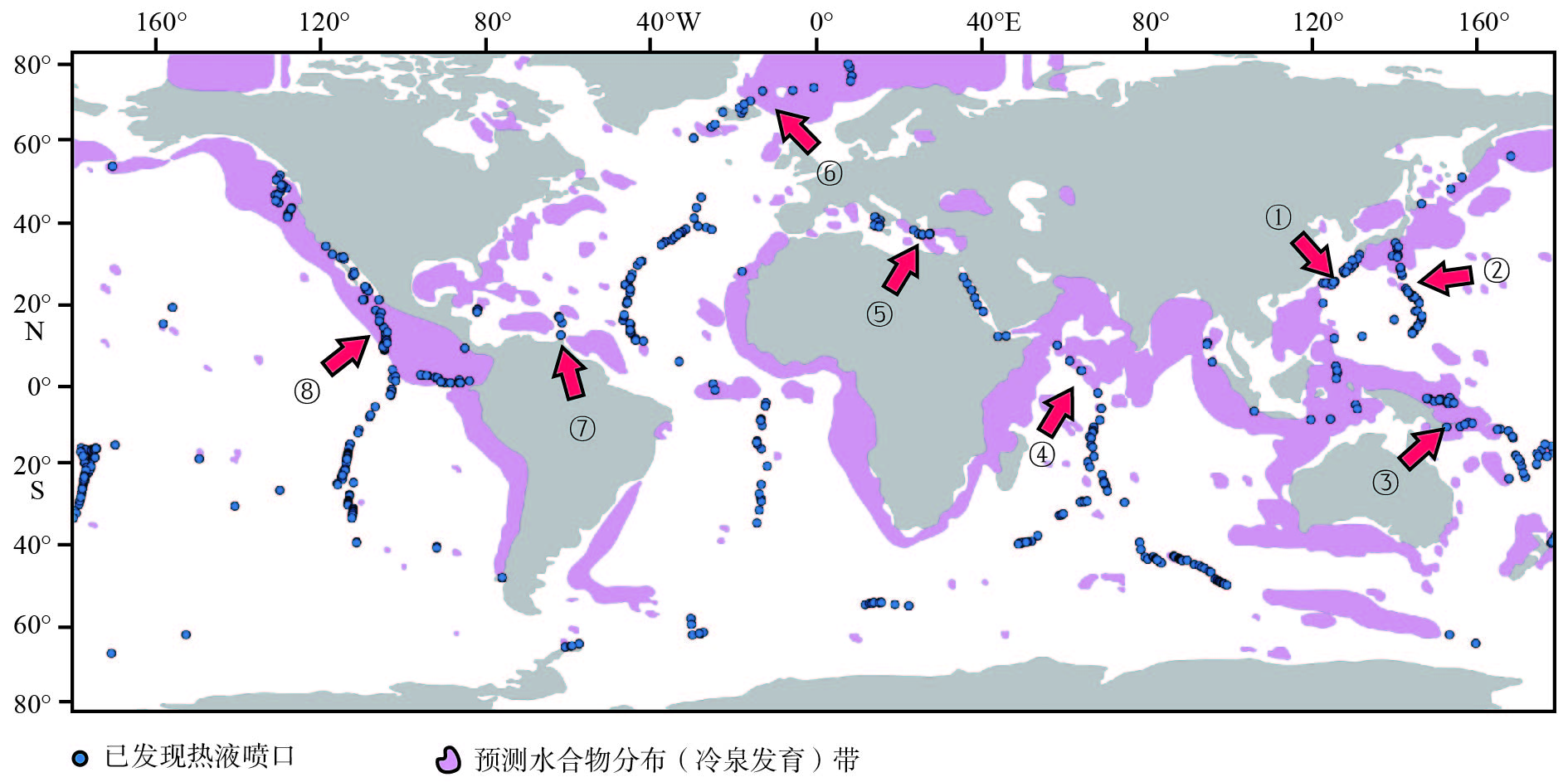
 下载:
下载:
